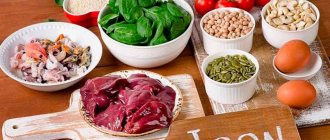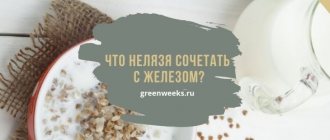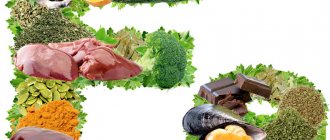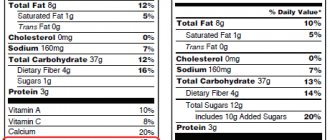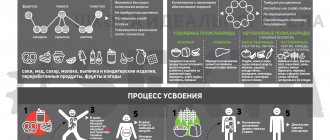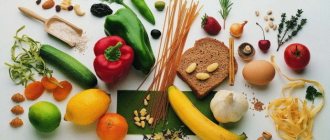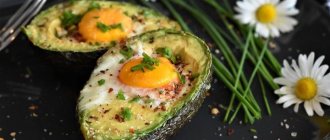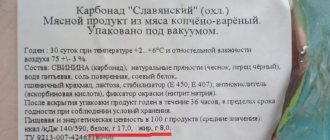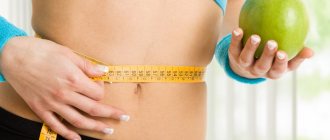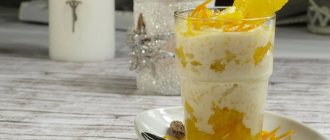Excess weight is not always associated with a predominantly sedentary lifestyle and banal overeating. There are many girls who go to the gym and stick to a diet, but cannot lose weight. The reason for this is often a deficiency of iron, a microelement that has a direct effect on metabolism and thyroid function. If such a problem occurs, the efforts made not only do not produce any results, but, on the contrary, lead to an even greater gain of extra pounds.
Iron is an essential trace element responsible for many important functions for the human body. Its excess and deficiency negatively affect health and well-being. Both conditions are deviations from the norm, but most often people suffer from a deficiency of this microelement.
How much iron does a person need per day?
The amount of iron you need from food each day depends on your age and gender, and whether you eat animal foods. Average daily iron intakes are listed below and are expressed in milligrams (mg). Vegetarians who do not eat meat or seafood need almost twice as much iron as indicated in the table, since the human body absorbs “non-heme” iron from plant foods less well than it absorbs “heme” iron from animal foods (source 1).
| Gender/age | mg iron per day |
| For babies 0-6 months | 0,27 |
| For babies 7-12 months | 11 |
| For children 1-3 years old | 7 |
| For children 9-13 years old | 8 |
| For men 14-18 years old | 11 |
| For men 19 and older | 8 |
| For women 14-18 years old | 15 |
| For women 19-50 years old (before menopause) | 18 |
| For women over 50 years of age (postmenopausal) | 8 |
| For pregnant | 27 |
| For breastfeeding women (in the absence of menstruation) | 9 |
General recommendations for men of all age groups and post-menopausal women are 8 mg iron per day, and for menstruating women 18 mg/day. The tolerable upper limit of iron intake for adults is 45 mg per day. If this level is exceeded, gastrointestinal upset may occur (source2).
Reviews and results
This food is complete and varied in composition, contains an increased amount of protein - the patient receives protein products 5 times a day (including kefir or milk at night). Reviews often contain messages from patients who have suffered severe pneumonia or surgery and who were prescribed this diet.
- “... After several operations, hemoglobin decreased. It is clear that good protein nutrition was needed. Already at the hospital they began to bring rabbit, boiled beef tongue, red and black caviar, liver pate with egg yolks, freshly squeezed pomegranate juice, and persimmon. At home, she continued to eat heavily, plus she ate a mixture of nuts, dates, raisins, prunes with the addition of one lemon along with the peel and 2 tablespoons of honey. I put everything through a meat grinder and ate a tablespoon 2 times a day. After a month I began to feel more cheerful”;
- “... I had severe anemia - we even thought about a blood transfusion, but I managed with medication and increased nutrition. At that time, I fainted every other day, my skin and hair were in terrible condition. Hemobin is an excellent remedy - it returned to normal in 3 weeks, but I was told to take it for another month. As for nutrition, the doctor focused more on red meat and seafood than on vegetables and fruits. I ate intensely for 2 months, the main products were: liver, rare steaks from red meat, cranberry juice, shellfish and oysters (but very expensive) and, oddly enough, chokeberry, mashed with sugar, helped very well.”
- “... I didn’t know about anemia before pregnancy. Terrible weakness and drowsiness began to plague me from the second month. I noticed that cracks began to appear in the corners of my mouth and my nails were breaking. There was no toxicosis, and there was a normal appetite. They checked my hemoglobin and immediately prescribed the drug Ferlatum plus food: more meat, liver, they bought black caviar, tongue, rabbit and turkey for me. I tried not to cook them too much to preserve all the vitamins. I ate a lot of persimmons and pomegranates, drank carrot and beet juice, but they were so caustic, so after a week I started feeling discomfort in my stomach.”
The dangers of iron deficiency and lack of iron-containing foods in the diet
Above we talked about what role iron plays in the body and how much a person needs per day. Before we get into the iron-rich foods tables, we need to say a few more words about iron deficiency, the most common nutritional deficiency in the world.
When the body's iron consumption is not compensated by adequate dietary iron intake, latent iron deficiency occurs (first, low ferritin, then decreased iron levels in serum and carrier proteins), which eventually develops into iron deficiency anemia. With anemia, there is no longer enough red blood cells and hemoglobin in a person’s blood. The main symptoms of this condition are fatigue, weakness and irritability. If anemia is not treated promptly, a person may experience a fast or irregular heartbeat, shortness of breath, dizziness, deterioration of the skin, hair, and nails, complications during pregnancy, and slow growth in infants and children (sources, ).
Fortunately, unless your anemia is caused by frequent blood loss or problems with the body's absorption of iron, you can overcome iron deficiency by including foods high in iron in your diet. And this is not the notorious pomegranate, which contains only 0.3 mg of iron per 100 g of product, and not even such quickly oxidizing foods as avocados (0.55 mg/100 g), bananas (0.26 mg/100 g) and apples (0.12 mg/100 g).
"Iron" plan
As always, it is recommended to consult your doctor if you are concerned about anemia. You may also have other conditions that impair absorption and require additional medical attention.
While it may be difficult to meet your iron needs if you don't eat meat or have increased requirements due to pregnancy, it is possible to get enough iron by eating a nutritious diet full of gluten-free fruits, vegetables and grains.
A balanced diet is the key to effectively pumping iron and keeping your body healthy.
TOP 18 foods containing large amounts of iron:
This list includes the animal and plant foods with the highest iron content per 100g, without taking into account the absorption of iron from different sources. According to Vegetarian Journal, vegans are recommended to eat about 1.8 times more iron from plant sources than non-vegetarians.
- Shellfish: from 7 to 14 mg of iron per 100 g of finished product;
- Liver, kidneys, heart: from 7 to 18 mg/100 g, stewed or fried;
- Legumes: from 2 mg for peas, to 15 mg for soybeans;
- Dark chocolate: 6-12 mg iron/100 g;
- Caviar: 11-12 mg;
- Seeds: from 5.7 mg for flax to 14.5 mg for sesame;
- Cashew nuts: 6-6.7 mg iron;
- olives , canned: 6.3 mg;
- Meat and poultry: 0.5-5 mg (2.5-5 mg for beef, 3-4.5 mg for ducks, geese, quail);
- Greens and cabbage: 1 mg (romaine lettuce) to 17.5 mg (thyme);
- Dried fruits: from 1 to 7 mg (2.6 mg of iron in 100 g of dried apricots, 3.5 mg in prunes);
- Quail eggs: 3.7 mg;
- Bran and cereals , especially amaranth, quinoa, bulgur: from 1 mg (boiled bulgur) to 18 mg (rice bran);
- Algae: 2-8 mg in raw form, 28.5 mg in dried spirulina;
- Fish: 1-2 mg baked, fried or grilled;
- Goat cheese: 1.6-1.9 mg;
- Onions and garlic: 1-2 mg;
- Mushrooms: from 1 mg (honey mushrooms, oyster mushrooms) to 12 (morels).
Source of figures: food composition databases. Detailed tables for all product categories are provided below in this article.
Menu (Power Mode)
The range of products is varied, as there are no significant restrictions. Nutrition should be complete and high in calories. You can consume gray and black bread up to 300 g per day, butter and vegetable oil up to 30 g.
Breakfast should be complete and must contain a protein dish (boiled meat, fried or stewed liver, eggs, cutlet, fish) with a side dish of cereals or vegetables. Weak tea with milk, cheese, bread, butter and honey.
The second breakfast includes cheese, fish of any method of preparation, stewed or raw vegetables, milk or rosehip infusion, any juice.
At lunch, the first courses should be cooked in meat, chicken or fish broth with a piece of meat, fish or meatballs. Second courses are also protein (stew, liver, meat or fish cutlets, turkey, rabbit) with vegetable or cereal side dishes, vegetable salads. You can prepare compotes from dried and fresh fruits, juices, and jelly.
The afternoon snack includes cottage cheese dishes, fresh fruits or berries (you can make mousses and jellies from them), tea with milk.
Dinner should also contain two courses. This can include meat and fish dishes with your favorite side dish and cottage cheese casserole with jam and milk.
At night - a fermented milk drink of your choice: kefir, yogurt, yogurt, acidophilus, fermented baked milk.
Difference in iron from animal and plant foods
The best food sources of iron contain “heme” iron, which is easier to absorb and virtually uninhibited by medications or other dietary components. Heme iron comes from hemoglobin and, accordingly, is found in foods that originally contained hemoglobin: meat, fish and poultry. Additionally, some studies have shown that iron is better absorbed when it chelates (interacts) with amino acids (source). And from our article What foods contain protein, you could find out that meat, fish and poultry are the highest quality sources of amino acids.
Non-heme iron is found in large quantities in both meat and plant foods such as soybeans, lentils, cabbage, leafy vegetables, cashews, seeds, mushrooms and dried fruits. However, some of them may also contain substances that interfere with the absorption of iron, for example, polyphenols, oxalates and phytic acid. Legumes and dark green leafy vegetables (including broccoli, kale and some leafy greens) are considered good sources of iron for vegans. In contrast, spinach and chard are high in oxalates, which bind iron and make it virtually unavailable for absorption.
More than 85% of the iron in the average human diet is non-heme, but less than 20% of this iron is absorbed into the body. For this reason, it is recommended to combine plant sources of iron in one meal with vitamin C, which helps the body absorb iron. Examples of such combinations: bean salad with bell pepper, spinach with lemon juice, sun-dried tomatoes with herbs. Sources: , , , .
Does calcium affect iron absorption?
A number of studies have shown that calcium can inhibit iron absorption. This point is often a concern because calcium is an important part of the diet of children and pregnant women, who are already at risk of iron deficiency. However, the results of most human studies have shown that Ca has only a minor effect on iron absorption unless Ca intake is typically very low. Sources: , .
Read the blog Forest Fairy: What foods contain calcium
Features of the diet during pregnancy
Doctors recommend eating beef and rabbit meat. The latter is more preferable, as it is easier to digest (minimizing the likelihood of diarrhea and toxicosis, which happens very often in pregnant women).
During pregnancy, the daily iron requirement increases to 30 mg per day (for others - only 10 - 15 mg). Therefore, it is unlikely that you can get by with meat alone. You should definitely include plant foods in your diet, as well as folic acid (in the form of multivitamin complexes).
Tables of iron content in animal products
The first table we prepared shows which foods contain the most iron. The highest iron content per 100 g is found in products of animal origin, but not meat, but the spleen, liver, kidneys, hearts and lungs of livestock, as well as poultry offal.
Table 1. Iron content in meat and offal
A few notes:
- Unlisted raw lungs and kidneys contain approximately the same amount of iron as raw liver.
- In unspecified parts of beef there is an average of 2.5 to 3.5 mg of iron per 100 g of product prepared by any method, in lamb - from 1.6 to 2 mg, in veal and turkey - on average 1-1.5 mg, in chicken – 1.4 mg, the least – in pork (0.5-1.5 mg).
- Game meat has a significantly higher iron content than domestic animals and poultry.
- Vegetarian meat substitutes contain on average 12 mg of iron per 100 g of product with a calorie content of 311 kcal.
Also read: What oil to fry in without harm to health
Other animal foods that contain large quantities of iron are shellfish, caviar, algae, fish and crustaceans.
Table 2. Iron content in fish and seafood
Table 3. Other animal foods high in iron
How to raise hemoglobin with nuts
If you decide to replenish your iron deficiency with nuts, you should, first of all, consume them correctly. To do this, do not combine the intake of such fruits with dairy products, coffee, tea (which people love to wash down with nuts) and limit the consumption of fats.
It is quite possible to replenish iron deficiency with the help of various foods (including nuts), only if the decrease in hemoglobin is not critical.
To accurately find out the situation with hemoglobin, you should definitely do a biochemical blood test. If the numbers are reduced, but not less than 100, it is quite possible to compensate for the microelement deficiency with food (just not for pregnant women); for them, the 100 mark is already critical, and food alone cannot do it.
If hemoglobin levels are below 100, this is already a serious reason, in addition to a balanced diet, to take medications prescribed by a qualified doctor.
Iron content in plant foods
We present to you 7 more tables prepared by us, clearly demonstrating in which plant foods you will find the most iron.
Table 1. Iron content in legumes
Table 2. Iron content in cocoa and chocolate
Table 3. Mushrooms - foods containing large quantities of iron
Note: since mushrooms lose a lot of size after cooking, a 100 g serving of fried or boiled mushrooms will have significantly higher iron content than 100 g of raw mushrooms.
Also read: Which foods contain a lot of vitamin B12?
Table 4. Iron content in vegetables and herbs
Iron content in dried and boiled vegetables (per 100 g of product):
- Sun-dried tomatoes: 9.09 mg iron, 258 kcal;
- Potato peel, baked: 7.04 mg, 198 kcal;
- Spinach, boiled: 3.57 mg, 23 kcal;
- Pumpkin leaves, boiled: 3.20 mg, 21 kcal;
- Chard, boiled: 2.26 mg, 20 kcal;
- Carrots, dried: 3.93 mg, 341 kcal;
- Beet greens, cooked: 1.90 mg, 27 kcal;
- Dandelion greens, boiled; 1.80 mg, 33 Kcal;
- Rapini, boiled: 1.27 mg, 25 kcal;
- Brussels sprouts, boiled: 1.20 mg, 36 kcal;
- Collard greens, boiled: 1.13 mg, 33 kcal;
- Baked potatoes with skin; 1.08 mg, 93 Kcal;
- Red tomatoes, stewed: 1.06 mg, 79 kcal;
- Acorn squash, baked: 0.93 mg, 56 kcal;
- Asparagus, boiled: 0.91 mg, 22 kcal.
Table 5. Iron content in dried fruits, berries and fruits
Also read: The healthiest berries + KBJU, vitamins and minerals in their composition
Table 6. Which grain products are high in iron?
Iron content in some cooked cereals per 100 g:
- Amaranth: 2.10 mg, 102 Kcal;
- Teff: 2.05 mg, 101 Kcal;
- Spelled: 1.67 mg, 127 Kcal;
- Quinoa: 1.49 mg, 120 Kcal;
- Barley: 1.33 mg, 123 Kcal;
- Bulgur: 0.96 mg, 83 kcal.
Also read: The healthiest cereals + tables of their composition
Table 7. Iron content in nuts and seeds
Note: Sesame paste contains 19.20 mg of iron at 586 Kcal, and tahini contains 8.95 mg at 595 Kcal.
Fresh juices
Store-bought juices will not be useful in the battle with low hemoglobin; only natural products will be useful. Freshly squeezed drinks are perfectly absorbed and are rich in a huge number of vitamins. During the treatment process, it is worth preparing them two to three times a day and using them immediately after preparation.
Champions for eliminating iron deficiency in the body: carrot, apple, beet juice. Other freshly squeezed foods will also benefit.
- Fresh zucchini juice mixed with carrot or potato juice is extremely beneficial. It activates intestinal peristalsis, has a calming effect, and promotes the absorption of iron thanks to potassium, magnesium and vitamin C.
- Potato (freshly squeezed) juice helps solve the problem of low hemoglobin. The drink is drunk 30 minutes before a meal; it is enough to take about half a glass 2-3 times a day. Red potatoes are optimal for making juice.
- The benefits of pomegranate juice, once popular as a drink that restores iron levels in the body, are disputed by modern medicine. It is believed to cause constipation and a number of other side effects.
Carrot
Carrot juice has long been used to improve hemoglobin synthesis in the body. To restore the process, you need to drink about 2-3 glasses a day, about half an hour before meals (or an hour after meals).
Excellent results will be provided by a drink prepared from freshly squeezed juices of beets, carrots and radishes. To improve the situation with hemoglobin and increase the concentration of iron in the blood, the composition is taken in the amount of 2 tablespoons per day, treatment lasts a month.
In order for carrot juice to be better “perceived” by the body, you should eat sour cream (in a small amount) before drinking it, so the valuable components will be better absorbed.
Beetroot
Beets are a useful product for low hemoglobin, especially effective in the form of freshly squeezed juice. Good results are ensured by consuming a mixture of carrot and beetroot drinks, the recommended proportion is 2:1.
Beetroot juice should not be taken in large quantities due to its increased biological activity. The drink may have an irritating effect on the mucous membranes. Therefore, you should drink it exclusively in combination with soft formulations, not exceeding a dose of half a glass per day (divided into several doses). You should definitely keep the freshly prepared mixture in the refrigerator for 3 hours in an open container.
Apple
Unlike beet and carrot juice, which do not have an attractive taste in their pure form, apple juice is a tasty medicine. To enrich the body with iron, you can use it either alone or in combination with the juice of other vegetables (carrots, beets).
For example, you can prepare a drink by taking a quarter glass of carrot juice, a quarter of beet juice, and half of apple juice. The thoroughly mixed mixture is consumed twice a day.
All of the above products are not only effective tools for increasing hemoglobin, but also preventing problems associated with it. They should be included in the menu of pregnant women and children, if there are no contraindications.
Spices are the foods that contain the most iron per 100 g.
Since spices and seasonings are not staple foods and are added to dishes in rather modest quantities, we did not include them in our TOP 18 best sources of iron. However, they are the true record holders for iron content per 100 g. Therefore, at the end of the article, we present to you a list of the TOP 15 spices for iron content:
- Thyme, dried: 123.60 mg;
- Basil, dried: 89.80 mg;
- Mint, dried: 87.47 mg;
- Marjoram, dried: 82.71 mg;
- Jeera (cumin seeds): 66.36 mg;
- Turmeric, ground: 55.00 mg;
- Dill, dried: 48.78 mg;
- Celery seeds: 44.90 mg;
- Bay leaf: 43.00 mg;
- Coriander leaves, dried: 42.46 mg;
- Savory, ground: 37.88 mg;
- Anise seeds: 36.96 mg;
- Oregano, dried: 36.80 mg;
- Fenugreek seeds: 33.53 mg;
- Tarragon, dried: 32.30 mg.
What is preventive medicine?
Modern science and medicine offer a special new model for managing your appearance and health, which is distinguished by a progressive approach and effectiveness - this is personalized preventive medicine.
Preventive medicine is, on the one hand, a comprehensive diagnosis that allows us to identify potential risks to the patient’s health, possible hereditary diseases and pathologies, and on the other hand, the prevention of diseases, minimizing risks and preserving youth, activity, and health for the longest possible time. It opens up endless prospects for taking care of your health and takes a logical approach to improving your quality of life.
Other Important Recommendations
At the same time, the diet should contain other food groups, among which, first of all, it is worth noting the following:
- fresh seasonal fruits - apples, mangoes, bananas, feijoas, citrus fruits, pineapples, red grapes;
- vegetables - beets, tomatoes, turnips, pumpkin, zucchini;
- greens, salads;
- porridge - buckwheat, rice, millet, oatmeal;
- oils - flaxseed, olive, sesame;
- liver - cod liver, pork, beef, chicken and turkey.
In general, your diet must be formed taking into account the individual characteristics of the body and in accordance with the recommendations of the supervising general practitioner. In some cases, it is advisable to include the diet in a limited dosage and for medicinal purposes, dry red wine, cognac and black natural coffee.
In addition, it is extremely important for the health of the entire body to lead a healthy lifestyle. By and large, this concept is based on not so complicated things:
- try to choose housing in a place with a clean environment;
- get rid of the habit of being nervous about any reason and experiencing stress;
- maintain a sleep schedule;
- drink enough clean water;
- to refuse from bad habits;
- spend time walking in the fresh air and playing sports.
